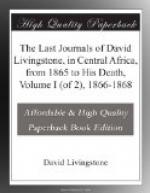A fine young man, whose father had been the Casembe before this one, came to see us; he is in the background now, otherwise he would have conducted us to the village: a son or heir does not succeed to the chieftainship here.
21st November, 1867.—The River Lunde was five miles from Chungu. It is six yards wide where we crossed it, but larger further down; springs were oozing out of its bed: we then entered on a broad plain, covered with bush, the trees being all cleared off in building a village. When one Casembe dies, the man who succeeds him invariably removes and builds his pembwe, or court, at another place: when Dr. Lacerda died, the Casembe moved to near the north end of the Mofwe. There have been seven Casembes in all. The word means a general.
The plain extending from the Lunde to the town of Casembe is level, and studded pretty thickly with red anthills, from 15 to 20 feet high. Casembe has made a broad path from his town to the Lunde, about a mile-and-a-half long, and as broad as a carriage-path. The chief’s residence is enclosed in a wall of reeds, 8 or 9 feet high, and 300 yards square, the gateway is ornamented with about sixty human skulls; a shed stands in the middle of the road before we come to the gate, with a cannon dressed in gaudy cloths. A number of noisy fellows stopped our party, and demanded tribute for the cannon; I burst through them, and the rest followed without giving anything: they were afraid of the English. The town is on the east bank of the Lakelet Mofwe, and one mile from its northern end. Mohamad bin Saleh now met us, his men firing guns of welcome; he conducted us to his shed of reception, and then gave us a hut till we could build one of our own. Mohamad is a fine portly black Arab, with a pleasant smile, and pure white beard, and has been more than ten years in these parts, and lived with four Casembes: he has considerable influence here, and also on Tanganyika.
An Arab trader, Mohamad Bogharib, who arrived seven days before us with an immense number of slaves, presented a meal of vermicelli, oil, and honey, also cassava meal cooked, so as to resemble a sweet meat (I had not tasted honey or sugar since we left Lake Nyassa, in September 1866): they had coffee too.
Neither goats, sheep, nor cattle thrive here, so the people are confined to fowls and fish. Cassava is very extensively cultivated, indeed, so generally is this plant grown, that it is impossible to know which is town and which is country: every hut has a plantation around it, in which is grown cassava, Holcus sorghum, maize, beans, nuts.
Mohamad gives the same account of the River Luapula and Lake Bemba that Jumbe did, but he adds, that the Chambeze, where we crossed it, is the Luapula before it enters Bemba or Bangweolo: on coming out of that Lake it turns round and comes away to the north, as Luapula, and, without touching the Mofwe, goes into Moero; then, emerging thence at the north-west end it becomes Lualaba, goes into Rua, forms a lake there, and afterwards goes into another lake beyond Tanganyika.




